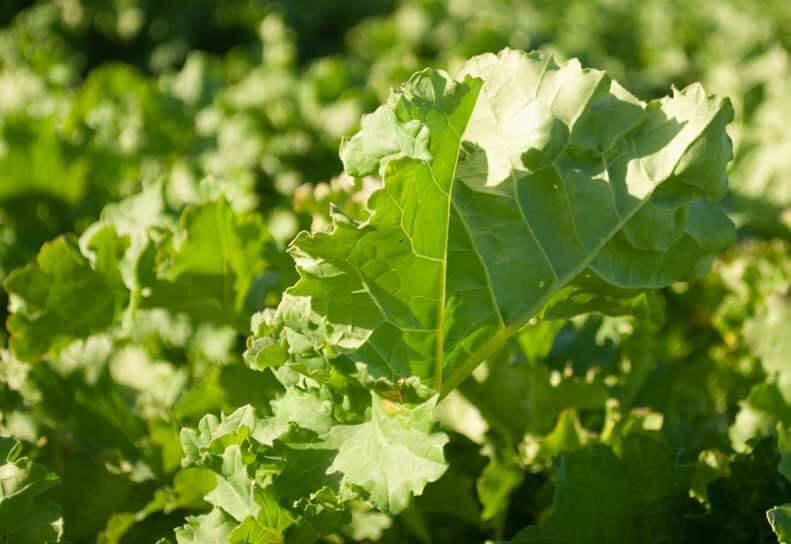The first new forage brassica species in Australia since the 1980’s.
Pallaton provides feed when farmers need it most bridging the summer/autumn feed gap for beef, sheep and dairy as a result of its impressive water use efficiency. Pallaton is high yielding, aphid tolerant, highly palatable and displays drought tolerance and strong plant persistence under multiple grazings. In order to obtain maximum value from your Pallaton Raphno® crop, best practice management is essential.
WHAT IS A RAPHANOBRASSICA?
Pallaton Raphno® is a raphanobrassica, a hybrid between Brassica oleracea (kale) and Raphanus sativus (radish). It is high yielding offering flexible grazing as early as 56 days after sowing, but can also be deferred up to 100 days after sowing. It is persistent under multiple grazings and has shown high palatability to stock. With efficient user of water and aphid resistance it is perfect for many farming operations.
AGENCY ONLY
Pallaton Raphno® is sold by the hectare, and is sown at a rate of 8 kg/ha. Pallaton seed should be sown at a depth of approximately 10 mm and rolled until firm. Sow at soil temperatures of 10°C and rising. Available under agency agreement through accredited retailers only such as Notman Pasture Seeds.
5 IMPORTANT TRAITS OF RAPHANOBRASSICA
The goal of the breeding programme was to combine six stacked traits, which would perform for Australian farmers within increasingly challenging environments.
HIGH YIELDING
14% increased yield advantage relative to Goliath forage rape in a multi-graze system (total cumulative yield from repeat harvest).
FLEXIBILITY
Graze Pallaton as early as 56 days after sowing (DAS), to maximise crop utilisation and regrowth potential. It can deferred up to 100 DAS, however utilisation and regrowth potential will be reduced. Pallaton does not have a specific maturity requirement.
WATER EFFICIENCY
38% increase in water use efficiency (WUE) relative to Goliath® forage rape.
PERSISTENCE & MULTIPLE GRAZINGS
Pallaton has excellent regrowth potential and has the ability to persist for 4-5 grazings over a 12 month period.
APHID TOLERANCE
32% increase in aphid tolerance relative to forage rape. Pallaton also has a higher level of tolerance to White Butterfly and Diamondback Moth.
Watch more on Raphanobrassica

PALLATON RAHPNO MANAGEMENT
CROP ROTATION
Use Pallaton Raphno® as part of a sensible crop rotation. Brassica (including Pallaton) should not be planted more than 2 years in a row in the same paddock. Let the paddock rest before sowing another brassica into the same
paddock.
GROUND PREPARATION
Spray the target paddock out with a recommended rate of glyphosate and penetrant. At least three days following spray out, hard graze to remove existing vegetation prior to cultivation. Cultivate to prepare a FINE, FIRM and WEED-FREE seed bed. Spray with an insecticide after sowing.
NO-TILLAGE
Best practice is to double-spray, with the initial spray out at least six weeks prior to sowing. A second spray with glyphosate occurs prior to drilling and should include an insecticide. Always use slug bait when direct drilling.
PRE-SOWING FERTILISER
All brassica crops respond strongly to nitrogen and phosphate. It is recommended that paddocks sown into Pallaton are soil tested at least six months prior to planting so nutrient deficiencies can be corrected prior to crop establishment.
SOWING
Pallaton Raphno® is sold by the hectare and is sown at a rate of 8 kg/ha. Pallaton seed should be sown at a depth of approximately 10 mm and rolled until firm. Sow at soil temperatures of 10°C and rising.
DRY MATTER YIELD ASSESSMENT
Assess the amount of feed (kgDM/ha) on offer prior to grazing in order to calculate the allocation AND/OR stocking rate of the Pallaton crop.

Ready to find out more?
Drop us a line today for more agronomy information









